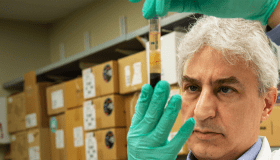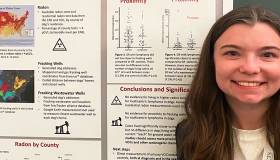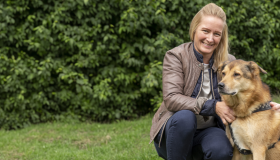April 12, 2016 – Laura Mae Sudder was introduced to HC (short for House Cat) when he was a 6-month-old abandoned cat that needed a costly surgery. Laura Mae’s veterinarian thought the two would be a good match, and the next thing Laura Mae knew, she was taking HC home.
HC quickly became a fixture in Alexandria, Virginia, bumping along the old bricked streets in his wheeled cart. HC went everywhere, knew everyone, and enchanted all with his outgoing personality. He was Laura Mae’s everything, and delighted in pleasing her and everyone she knew. “I feel he was a special gift,” said Laura Mae.
The ginger cat was the picture of health until one fateful day in October 2013. Laura Mae was petting HC and noticed him flinch near his right hindquarter. At first, she thought he was developing arthritis, and the problem seemed to go away. It flared again in December, and Laura Mae took HC to her veterinarian. The veterinarian discovered a tumor, and Laura Mae and HC began a journey that took them to the North Carolina State University College of Veterinary Medicine where he was diagnosed with injection-site sarcoma.
Dr. Rachael Thomas started her research career planning on studying human cancer. She didn’t know it at the time, but a year spent at the Animal Health Trust, a nonprofit organization based in the United Kingdom, would change the course of her research life forever. Years after her stint at Animal Health trust, Dr. Thomas found herself in a position to study injection-site sarcoma.
“As a child, I had a cat that developed an injection-site sarcoma,” said Dr. Thomas, a research assistant professor in genomics at North Carolina State University’s College of Veterinary Medicine. “Bodkin was our family cat, and as the youngest child, I formed a close bond with her. We grew up together. I remember that when I heard she had cancer, I was old enough to understand it was serious. I was anxious and paralyzed by the fact there was nothing we could do. I felt vulnerable.”
Her hope now is that not only can she improve understanding of this invasive cancer, but also provide better information for owners.
“I want to give them information that they can take home,” said Dr. Thomas. “I remember my anxiety as a child, and much of it was due to the lack of information about the cancer. Not knowing, and realizing there were no answers, made the situation worse.”
Injection-site sarcomas are caused by injections, which in susceptible individuals can result in tumor formation. The cruelty of ISSs is they arise from medications and vaccines used to help keep animals healthy, or help them recover from injury or illness. The tumor invades into surrounding tissue, making surgery difficult. Radiation and chemotherapy are used as adjunctive therapy, but ISS is rarely curable.
The oncology team at NC State did everything they could to save HC's life. He endured surgery, chemotherapy and radiation with the same good humor, intelligence and love that he brought to his friends in Alexandria.
“Everyone was doing so much to save him,” Laura Mae said. “HC was putting up a fight. I could see the anguish on the doctors’ and the staff’s faces when we went in for treatment.”
HC’s passing was mourned by everyone who knew him, from the colonial streets of old Alexandria to the sparkling halls of NC State’s veterinary hospital. The heartbreak of losing her special companion remains with her, but Laura Mae continues to hope research on ISS will help ensure cats with this cancer have a brighter future.
For Laura Mae, and cat owners worldwide, Dr. Thomas is a face of hope in the fight against injection-site sarcoma. Her research into the molecular mechanisms and genetics driving ISS formation, supported with a grant from Morris Animal Foundation, might one day lead to better treatments and preventive strategies for this aggressive cancer. Learn more about our work in injection-site sarcoma in cats.




